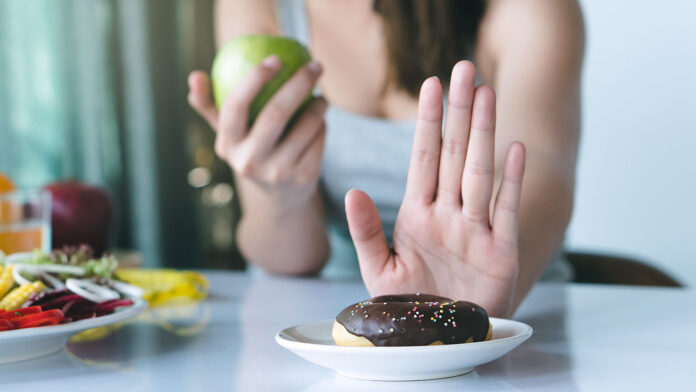Sugar is a tempting treat for just about everyone and breaking the habit can be hard, especially for a ferocious sweet tooth. One reason is that sugar is in so many food products that daily consumption is not easy to monitor. A person may be consuming a high-sugar diet and not even know it.
The problem with that is the more sugar in a diet, the more the body craves sugar, according to science. Really, to get off this sugar hamster wheel, detox is key—just as detox is necessary for other substance addictions like drugs or alcohol. (Learn how detox works at FHE Health for people with drug and alcohol addictions.)
Once sugar is out of the system, it is easier to make those healthy choices that are necessary to overcoming a raging sweet tooth. The good news is that breaking a sugar habit is possible with consciousness and determination. Here are some tips for getting into a good headspace for managing cravings and tackling the challenges.
Contents
1. Decide why you want to stop.

Making a commitment means knowing why you are willing to make this change. Many people try to stop their sugar consumption for weight loss or a slimmer midsection. The truth is, that takes time, and the results are not immediate. Cutting sugar intake is also a great way to embark on a healthier lifestyle and better food choices.
Make a list of the top ten reasons for quitting sugar, so they are clear and in mind during times of temptation. A good place to start may be to consider all of the bad things that excess sugar can do to the body, compliments of the American Dietetic and Diabetic Association. Weight gain is certainly on the list, but there are also many physical issues made worse by sugar consumption: degenerative diseases, inflammation that can cause chronic pain, anxiety, and depression, acid reflux, fatigue, and migraines, among still other problems. Bodies were not designed for the modern diet of excess sugars.
2. Keep a log of “sugar encounters.”
When a sugar craving proves too hard to resist, record the before and after. Note the “trigger” (the event, feeling, etc.) that prompts the need for sugar.
After a while, the results can be eye-opening and instructive. Most people will tell themselves that they really want or need that piece of cake and will feel so much better after that piece of cake. It may take about two minutes to eat that piece of cake, and once it is gone, how do they feel?
A few people might really say, “That was totally worth it, and my life is so much better now.” Realistically, though, the thoughts that come are not that positive, because breaking a commitment to avoid sugar feels bad. Most people quickly recognize they did not need those extra calories, feel more defeated about weight loss goals, and see that whatever comfort they were looking for in that “magic cake” did not materialize.
In time, by logging these sugar encounters, people can begin to see a pattern. They start to see how many times sugar actually satisfied the perceived need. Happiness at the end of a box of donuts? Not likely.
Once it is clear that cravings are just that and do not solve the existing problem or situation, try experimenting with a healthier response to cravings. Do something that works better as a solution to the trigger. Keeping a log of this new habit can also be good.
3. Do something that does not involve eating.

Not all hunger is physiological. A lot of it can be psychologically triggered. People eat when bored, eat when its 12 noon, eat when friends are over, eat when stressed, and eat on autopilot.
Replace these automatic patterns with other activities that preclude eating sugary foods. Take the dog for a walk. Go outside and throw the frisbee. Call a friend. Clean the bathroom. Do yoga. Do something that will distract you from the craving and that will feel different. Often, what will happen is the urge to indulge passes.
4. Put the sugar in caloric reference.
There are some great web resources out there and conversion charts for the number of calories in sugar and the required physical exercise needed to burn those calories. Now, calories are not inherently good or bad, but the empty calories of a can of soda that takes climbing stairs for thirty minutes, five miles of walking, or 50 minutes of running to burn off one 20-ounce soda, can provide some much-needed perspective in the face of cravings.
Many people say they cannot imagine how they got so big or why their health is so bad, but a couple of sodas, a couple of processed food meals, or a couple of candies can add up fast. Bodies cannot do anything with all the carbohydrates and sugars we consume, so the body holds on to them to save for an energy-packed day in the future. The problem is that not only are many of us consuming more sugar, but we are also generally exercising less, so there is an obesity epidemic.
5. Eat sugar in front of the mirror … naked.

This may sound weird, but if that sugary treat is irresistible, then one way to become more conscious of the effects of one’s choices is to eat that brownie or banana split in front of a mirror naked. If you feel confident and like this experience, you are probably either very confident or sure of being healthy. For the rest of us, the experience can be a turn-off from making bad food choices.
Another way to frame these moments of capitulation to sugar and empty calories: Picture the reaction of friends, family or co-workers when they see literally everything that goes into your mouth across the course of a day or two. That alone can make many people more conscious of their sugar intake.
Nutritionists often keep a big lump of fat on exhibit in their office, as an illustration of what the body does with excess foods. From experience, it is gross. What goes in has to go somewhere.
Sugar promises a lot but delivers very little. Eliminating it from the diet can seem a struggle at first, but the benefits are well-worth it. People usually feel better, their health and appearance improve, and they gain a sense of pride about the fact that they are exercising good self-care.
Changing a habit naturally takes time. If the decision is to consume less or no sugar, make a game plan with goals, carry it through, and try to stay positive and learn about the process. A no-sugar diet may not be possible, but less sugar is.
The choices that people make really have long lasting consequences. Many people who did not take care of their bodies and end up at the doctor’s office or on the operating table say, “I wish I had….” But by then, it’s too late, the damage is done, and may or may not be reversible. When given the choice today, why not try and make a positive choice? Everyone is worth it.
This article was provided by Dr. Beau Nelson, DBH, LCSW, who is Chief Clinical Officer at the national behavioral health provider FHE Health.
















